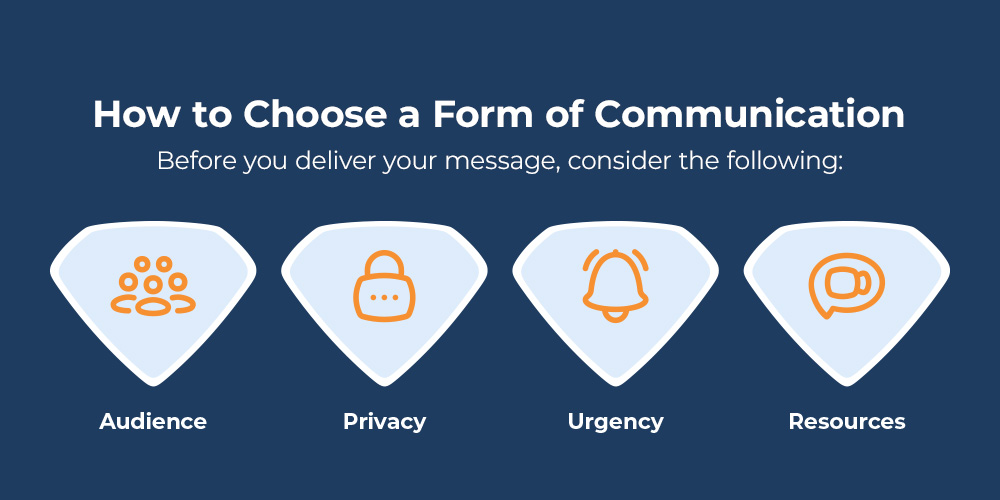Workplace communication skills are only as valuable as the method of communication you choose. You have many options for professional communication, but each channel has its benefits and disadvantages. Explore the different communication methods and how you can use them to meet your goals.
Before diving into different workplace communication styles, you need to understand your specific requirements. One of the top needs to consider is the type of audience you’re working with — B2B or B2C. In the case of B2B audiences, you often have more dynamic conversations that require various communication channels, whereas B2C audiences typically need more direct communication with just one or two methods.
When thinking about your communication needs, you ultimately want to consider the purpose of your message. Are you aiming to remind your client of something upcoming? Do you have actions for your client to take? Is there something you need to explain in great detail? With the clear goal of your message decided, you can find a communication channel that best aligns with that purpose.
You have many communication channels to work with when communicating with your clients.
When you have a brief message to share with one or multiple people, email makes it possible. Emailing is one of the best ways to provide quick, non-urgent information. Send an email for objectives like brief reminders, small updates and quick action items. This communication channel is also excellent for sharing resources, from invoices to data sheets.
While many of us default to email for our communication, sometimes a phone call is better for the task. Phone calls are recommended for instances when you need immediate contact with your client or customer. Calls are not typically something you’re expected to schedule, and they help you reach your client the moment you need them.
Getting on the phone is also an ideal option when you expect to get a lot of questions from your client. Rather than emailing back and forth over the course of days, phone calls allow you to address any confusion at the moment.
Video calls have quickly become preferred channels as video platforms have grown in popularity and accessibility. Most clients will expect a video call to be scheduled, setting it apart from a traditional phone call. Consider video conferences as an alternative to in-person meetings, especially if your client is not local.
One of the best use cases for a video call is a regularly scheduled meeting. For example, you may have a monthly video call with your clients to discuss updates to your services or progress toward a goal. With a video call, you can easily meet with multiple people, making it an excellent idea for B2B clients.
Face-to-face meetings may not always be possible, especially if you and your client are located in different places. Even so, this form of communication can be valuable for establishing a shared vision with your client within a short window. The more personal touch of a face-to-face meeting can also be valuable for first impressions. For example, you might request an in-person meeting during the sales process to encourage someone to buy.
Cloud-based collaboration tools for word processing and data sharing can be a valuable communication channel for more casual discussions or brainstorming. For example, you might provide a list of information to your client in a document, and they can leave comments to build off your ideas.
This approach is ideal when your goals are non-urgent but you still want client input. Often, collaboration tools like these are used in conjunction with other communication channels, like email and video calls.

When you have a message to share, you need to find an effective communication method for what you want to convey. An email, for instance, won’t have nearly the same impact as a face-to-face meeting. But if you schedule an in-person meeting for just a short chat, the value of your message might be lost given the mismatched communication format.
Before you deliver your message, consider the following:
Knowing which communication channels to use for each scenario is a valuable part of a larger communication strategy. To truly implement this aspect of your strategy, you should train your team on the different communication channels and how to use them. It may also be helpful to create a resource that your team can access any time they’re unsure about which channel to choose.
After implementing this strategy, you can gauge the effectiveness of these communication channels through metrics like client satisfaction scores. The best way to get this information is through client surveys where your audience can voice their thoughts on the quality of communication, channels used and frequency of interactions.
Effective communication in the workplace is important, but you may not have the time or resources to manage it by yourself. For businesses dealing with a high volume of phone calls, turn to AnswerHero™. As a professional call answering service, AnswerHero™ ensures you answer every call, every time. Our around-the-clock call agents offer bilingual call answering to take messages, schedule appointments and transfer calls.
With our no-contract service and a range of plans, we can meet your needs, even as they change. Contact us today to get started.
